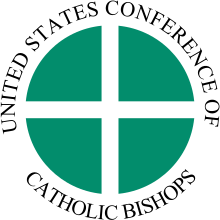Roman Catholic Archdiocese of Los Angeles
The Archdiocese of Los Angeles (Latin: Archidioecesis Angelorum in California, Spanish: Arquidiócesis de Los Ángeles) is an archdiocese of the Roman Catholic Church in the U.S. state of California. Based in Los Angeles, the archdiocese comprises the California counties of Los Angeles, Santa Barbara and Ventura. The cathedral is the Cathedral of Our Lady of the Angels in Los Angeles, and its present archbishop is José Horacio Gómez. With approximately five million professing members, the Archdiocese of Los Angeles is numerically the single largest diocese in the United States.
Archdiocese of Los Angeles Archidioecesis Angelorum in California Arquidiócesis de Los Ángeles | |
|---|---|
 Cathedral of Our Lady of the Angels | |
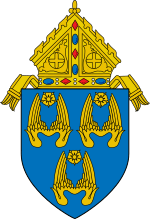 | |
| Location | |
| Country | |
| Territory | Los Angeles, Santa Barbara, and Ventura Counties |
| Ecclesiastical province | Los Angeles |
| Statistics | |
| Area | 14,019 km2 (5,413 sq mi) |
| Population - Total - Catholics | (as of 2015) 11,599,000 4,392,000 (37.9%) |
| Parishes | 287 |
| Information | |
| Denomination | Catholic |
| Sui iuris church | Latin Church |
| Rite | Roman Rite |
| Established | 1 June 1922 (As Diocese of Los Angeles-San Diego) 11 July 1936 (As Archdiocese of Los Angeles) |
| Cathedral | Cathedral of Our Lady of the Angels |
| Patron saint | Saint Vibiana, Saint Patrick, Saint Rita, Saint Emidius[1] |
| Secular priests | 590 |
| Current leadership | |
| Pope | Francis |
| Archbishop | José Gómez |
| Auxiliary Bishops | |
| Bishops emeritus | |
| Map | |
 | |
| Website | |
| lacatholics.org | |
The Archbishop of Los Angeles also serves as metropolitan bishop of the suffragan dioceses within the Ecclesiastical Province of Los Angeles, which includes the dioceses of Fresno, Monterey, Orange, San Bernardino, and San Diego.
Following the establishment of the Spanish missions in California, the diocese of the Two Californias was established on 1840, when the Los Angeles region was still part of Mexico. In 1848, Mexican California was ceded to the United States, and the U.S. portion of the diocese was renamed the Diocese of Monterey. The diocese was renamed the Diocese of Monterey-Los Angeles in 1859, and the episcopal see was moved to Los Angeles upon the completion of the Cathedral of Saint Vibiana in 1876. Los Angeles split from Monterey to become the Diocese of Los Angeles-San Diego in 1922. The diocese was split again in 1936 to create the Diocese of San Diego, and the Los Angeles see was elevated to an archdiocese. The archdiocese's present territory was established in 1976, when Orange County was split off to establish the Diocese of Orange.
History
Christianity in southern California dates back to the Spanish establishment of missions in what was then known as the Las Californias province of New Spain. From 1769 to 1823, the Franciscan order led by Junípero Serra and later by Fermín de Francisco Lasuén established twenty-one missions between present-day San Diego and Sonoma, six of which were located in the present-day territory of the Archdiocese of Los Angeles. In response to the 1781 establishment of the Pueblo de Los Angeles, in 1784 priests from Mission San Gabriel Arcángel set out for the pueblo and established the Nuestra Señora Reina de los Angeles Asistencia as a sub-mission. The asistencia fell into disrepair after being abandoned several years later, and La Iglesia de Nuestra Señora Reina de los Angeles was built on the site in 1814; the church remained the only Catholic church in Los Angeles for many years.
Las Californias was split into two provinces in 1804, and the area comprising present-day California became part of Alta California. In 1840, the diocese of the Two Californias was erected to recognize the growth of the provinces of Alta California and Baja California. The diocese was a suffragan diocese of the Archdiocese of Mexico with its episcopal see located in Monterey, and included all Mexican territory west of the Colorado River and the Gulf of California (the modern U.S. states of California and Nevada, and parts of Utah, Arizona, and Colorado, and the Mexican states of Baja California and Baja California Sur).
In 1848, Alta California was ceded to the United States after the Mexican–American War, and the Mexican government objected to an American bishop having jurisdiction over parishes in Mexican Baja California. The diocese was split into American and Mexican sections, and the American section was renamed the Diocese of Monterey. Another large split occurred in 1853, when much of present-day northern California, as well as present-day Nevada and Utah, formed the Archdiocese of San Francisco; Monterey became a suffragan of the new archdiocese. In 1859 the diocese became known as the Diocese of Monterey-Los Angeles to recognize the growth of the city of Los Angeles; the see was transferred to Los Angeles and to the new Cathedral of Saint Vibiana in 1876.
On June 1, 1922, the diocese split again, this time into the Dioceses of Monterey-Fresno and Los Angeles-San Diego. Bishop John Joseph Cantwell, who had previously been Bishop of Monterey-Los Angeles, became bishop of the Los Angeles-San Diego diocese, which comprised the counties of Imperial, Los Angeles, Orange, Riverside, San Bernardino, San Diego, Santa Barbara, and Ventura. On July 11, 1936, the diocese was elevated to become the Archdiocese of Los Angeles with John Joseph Cantwell as its first archbishop; concurrently, Imperial, Riverside, San Bernardino, and San Diego Counties were split to form the suffragan Diocese of San Diego, and the Diocese of Monterey-Fresno was transferred to become a suffragan of the new archdiocese. On March 24, 1976, Orange County was split to form the Diocese of Orange, establishing the archdiocese's present-day territory consisting of Los Angeles, Santa Barbara, and Ventura Counties.
In addition to the dioceses of Monterey, Orange, and San Diego, the archdiocese's present-day suffragan dioceses are Fresno (split from the Diocese of Monterey in 1967) and San Bernardino (split from the Diocese of San Diego in 1978).
Pastoral regions
In 1986, Archbishop Roger Mahony subdivided the Archdiocese of Los Angeles into five administrative pastoral regions. Each region is geographical, and is headed by an auxiliary bishop who functions as the region's episcopal vicar. The five regions are:
- Our Lady of the Angels, covering downtown and central Los Angeles west to Malibu, south to Los Angeles International Airport. The region has 78 parishes, 11 Catholic high schools, 5 Catholic hospitals, and 5 missions. The Episcopal Vicar is Bishop Edward William Clark.
- San Fernando, covering the San Fernando, Santa Clarita and Antelope Valleys and northeast Los Angeles. The region has 54 parishes, 12 Catholic high schools, 2 Catholic hospitals and 5 missions. Archbishop Gomez appointed Bishop Alejandro D. Aclan Episcopal Vicar for the San Fernando Pastoral Region in 2019.[2]
- San Gabriel, covering East Los Angeles through the San Gabriel Valley and the Pomona Valley. The region has 66 parishes, 13 Catholic high schools, 3 Catholic hospitals and 2 missions. Archbishop Gomez appointed Bishop David G. O'Connell Episcopal Vicar for the San Gabriel Pastoral Region in 2015.[3]
- San Pedro, covering Long Beach and southern Los Angeles County. The region has 67 parishes, 9 Catholic high schools, 6 Catholic hospitals and 1 mission. Archbishop Gomez appointed Bishop Marc V. Trudeau as the Episcopal Vicar for this region in 2018.
- Santa Barbara, covering Santa Barbara and Ventura Counties. The region has 37 parishes, 6 Catholic high schools, 4 Catholic hospitals, and 5 missions. Archbishop Gomez appointed Bishop Robert E. Barron Episcopal Vicar for the Santa Barbara Pastoral Region in 2015.[4]
Clergy sexual abuse settlements
On July 16, 2007, Cardinal Roger Mahony and the archdiocese reached a record-breaking settlement with 508 alleged victims of sexual abuse by priests. The settlement was worth $660 million, with an average of $1.3 million for each plaintiff. Mahony described the abuse as a "terrible sin and crime", after a series of trials into sex abuse claims since the 1940s were to begin. The agreement settled all outstanding civil lawsuits against the archdiocese and dwarfs the $157 million settlement paid by the Archdiocese of Boston since Massachusetts law places a legal dollar cap on how much money a non-profit group can be required to pay.[5]
In 2014 the diocese agreed to pay $13 million to settle a final group of 17 sex abuse lawsuits, including eleven that involved "a visiting Mexican priest who fled prosecution and remains a fugitive more than 25 years later". The settlement followed a court order forcing the Archdiocese to release files which showed that it had shielded accused priests, for example by ordering church officials not to turn over a list of altar boys to police who were investigating.[6]
From May to December 2019, the Archdiocese of Los Angeles provided numerous documents to California State Attorney Xavier Becerra in preparation for a series of pending lawsuits which are expected to be filed after a new California law which will temporarily remove the statute of limitations. The new law goes into effect on January 1, 2020.[7][8] The Archdiocese of Los Angeles is one of six Catholic dioceses throughout the state of California which is expected to be subpoenaed during the upcoming lawsuits.[7][8][9]
Archbishop

The archdiocese is led by the archbishop, who governs from the mother church, the Cathedral of Our Lady of the Angels. The cathedral was dedicated on September 2, 2002, and replaced the former Cathedral of Saint Vibiana, damaged in the 1994 Northridge earthquake.
The Archbishop of Los Angeles is the metropolitan of the Province of Los Angeles of the Roman Catholic Church. Its suffragans are the dioceses of Fresno, Monterey in California, Orange in California, San Bernardino, and San Diego. Metropolitan archbishops historically wielded great administrative powers over the suffragan dioceses. Today, such power is only ceremonial and kept as a tradition.
The Most Reverend José H. Gómez is the current Archbishop of Los Angeles, having automatically succeeded his predecessor, Cardinal Roger Mahony, who served for 25 years, upon the latter's retirement which took effect on March 1, 2011.[10] Previously, Gómez served as Coadjutor Archbishop of Los Angeles since his appointment by Pope Benedict XVI on April 6, 2010.[11][12][13] He previously served as Archbishop of San Antonio from 2004 to 2010, and as an auxiliary bishop of the Archdiocese of Denver from 2001 to 2004.[14] He is an ordained priest of Opus Dei.[15][16]
Archbishop Gómez is assisted by the current auxiliary bishops: Edward W. Clark, David O'Connell, Robert Barron, Marc Vincent Trudeau, and Alejandro D. Aclan. In addition, Joseph Martin Sartoris and Gerald Eugene Wilkerson are retired auxiliary bishops still living and residing within the archdiocese. Gordon Bennett, S.J., Bishop Emeritus of Mandeville, Jamaica, also resides within the archdiocese, as the Peter Faber, S.J., Fellow in Pastoral Theology and Ignatian Spirituality at Loyola Marymount University in Los Angeles.
Bishops
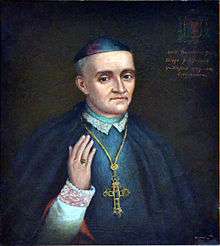


Ordinaries
Bishop of Two Californias
- Francisco Garcia Diego y Moreno (1840–1846)
Bishop of Monterey
- Joseph Alemany (1850–1853), appointed Archbishop of San Francisco
Bishops of Monterey-Los Angeles
- Thaddeus Amat y Brusi (1853–1878)
- Francisco Mora y Borrell (1878–1896)
- George Thomas Montgomery (1896–1902), appointed Coadjutor Archbishop of San Francisco
- Thomas James Conaty (1903–1915)
- John Joseph Cantwell (1917–1922)
Bishop of Los Angeles-San Diego
- John Joseph Cantwell (see above 1922–1936)
Archbishops of Los Angeles
- John Joseph Cantwell (1936–1947)
- James Francis McIntyre (1948–1970)
- Timothy Manning (1970–1985)
- Roger Mahony (1985–2011)
- José Horacio Gómez (2011–present)
Coadjutor bishops
- Francisco Mora y Borrell (1873–1878)
- George Thomas Montgomery (1894–1896)
Auxiliary bishops
Current
- Edward W. Clark (2001–present)
- David G. O'Connell (2015–present)
- Robert Barron (2015–present)
- Marc Vincent Trudeau (2018–present)
- Alejandro D. Aclan (2019–present)
Former
- Joseph Thomas McGucken (1941–1955), appointed Bishop of Sacramento and later Archbishop of San Francisco
- Timothy Manning (1946–1967), appointed Bishop of Fresno and later Coadjutor Archbishop and Archbishop of Los Angeles (elevated to Cardinal in 1973)
- Alden John Bell (1956–1962), appointed Bishop of Sacramento
- John J. Ward (1963–1996)
- Joseph Patrick Dougherty (1969–1970)
- William Robert Johnson (1971–1976), appointed Bishop of Orange
- Juan Alfredo Arzube (1971–1993)
- Thaddeus Anthony Shubsda (1976–1982), appointed Bishop of Monterrey in California
- Manuel Duran Moreno (1976–1982), appointed Coadjutor Bishop and later Bishop of Tucson
- Donald William Montrose (1983–1985), appointed Bishop of Stockton
- William Levada (1983–1986), appointed Archbishop of Portland in Oregon and later Archbishop of San Francisco and Prefect of Congregation for the Doctrine of the Faith (elevated to Cardinal in 2006)
- Carl Anthony Fisher (1986–1993)
- Armando Xavier Ochoa (1986–1996), appointed Bishop of El Paso and later Bishop of Fresno
- George Patrick Ziemann (1986–1992), appointed Bishop of Santa Rose in California
- Sylvester Donovan Ryan (1990–1992), appointed Bishop of Monterrey in California
- Stephen Blaire (1990–1999), appointed Bishop of Stockton
- Thomas John Curry (1994–2018)
- Joseph Martin Sartoris (1994–2002)
- Gabino Zavala (1994–2012)
- Gerald Eugene Wilkerson (1997–2015)
- Oscar Azarcon Solis (2003–2017), appointed Bishop of Salt Lake City
- Alexander Salazar (2004–2018)[17]
- Joseph Vincent Brennan (2015–2019), appointed Bishop of Fresno
Other bishops who once were priests of the diocese
- Note: Years in parentheses indicate the time of service as a priest of the Archdiocese of Los Angeles (or predecessor diocese), prior to appointment to the episcopacy.
- Robert Emmet Lucey (1922–1934), appointed Bishop of Amarillo and later Archbishop of San Antonio
- John Thomas Steinbock (1963–1984), appointed Auxiliary Bishop of Orange and later Bishop of Fresno
- Justin F. Rigali (1961–1985), appointed President of the Pontifical Ecclesiastical Academy and later Secretary of the Congregation for Bishops and the College of Cardinals, Archbishop of Saint Louis, and Archbishop of Philadelphia (elevated to Cardinal in 2003)
- Michael Patrick Driscoll (1965–1989), appointed Auxiliary Bishop of Orange and later Bishop of Boise
- George Hugh Niederauer (1962–1994), appointed Bishop of Salt Lake City and Archbishop of San Francisco
- Dennis Patrick O'Neil (1966–2001), appointed Auxiliary Bishop of San Bernardino
Schools
There are 5 colleges and over 50 high schools within the Archdiocese of Los Angeles. Many churches have affiliated primary schools as well.
Events
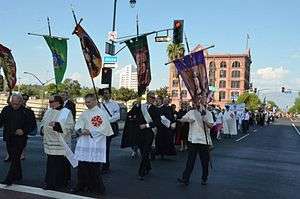
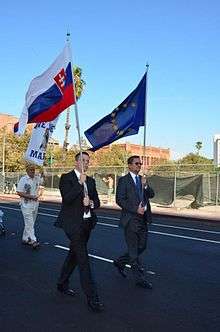
Religious education congress
The archdiocese's office of religious education produces the Los Angeles Religious Education Congress, the largest annual event of its kind in the United States, with an attendance of approximately 38,000.
Annual Marian procession and Mass
The archdiocese has entrusted the annual celebration of the Votive Mass in honor of Our Lady of the Angels to the Queen of Angels Foundation, a lay association of the Catholic Church founded by Mark Anchor Albert, dedicated to promoting devotion to the Blessed Virgin Mary. Each year since 2011, the Cathedral of Our Lady of the Angels has hosted a Votive Mass in honor of Our Lady, Queen of Angels. The Mass follows a Marian procession which originates from the historic Queen of Angels parish, which is part of the Los Angeles Plaza Historic District, and culminates at the cathedral.
Since 2011 the Queen of Angels Foundation has sponsored the annual Marian processions, Votive Masses, and fiestas in commemoration of Los Angeles' birthday and the feast of Our Lady of the Angels. Archbishop Gomez has been the homilist and principal celebrant of the annual Mass since 2012. Future Marian processions and Masses will coincide with the City of Los Angeles' official birthday celebrations on the last Saturday of August.
Holy days of obligation
As directed by the U.S. Conference of Catholic Bishops' Committee on the Liturgy and the Ecclesiastical Province of Los Angeles, the archdiocese annually observes four holy days of obligation. The Roman Catholic Church currently recognizes 10 holy days, established in the 1917 Code of Canon Law. However, the USCCB has reduced that number to 6 for Latin Church dioceses in the United States. As of January 1993, no provinces in the United States celebrate the solemnities of Epiphany, Corpus Christi, Saint Joseph, or the Apostles Saints Peter and Paul as holy days of obligation.[18] The Metropolitan Province of Los Angeles, which includes the L.A. Archdiocese, further modified the list, and as of 2019, celebrates four holy days of obligation on the days prescribed by canon law. The solemnity of the Ascension is transferred from Thursday of the sixth week of Easter to the seventh Sunday of Easter. The province has abrogated the obligation to attend Mass on the Solemnity of Mary, Mother of God.[19]
- Assumption of the Blessed Virgin Mary, August 15
- Exception: If August 15 falls on a Saturday or Monday, there is no obligation to attend Mass.
- All Saints, November 1
- Exception: If November 1 falls on a Saturday or Monday, there is no obligation to attend Mass.
- Immaculate Conception, December 8
- Exception: If December 8 falls on a Sunday, the solemnity is transferred to the following Monday and there is no obligation to attend Mass.
- Nativity of Our Lord Jesus Christ, December 25
Administrative handbook
The Archdiocese of Los Angeles, being one of the most diverse dioceses in the world, strives for all of their employees to live and work in accord with Catholic social teaching and servant leadership. "The dignity of the human person, the call to community and participation, rights and responsibilities, dignity of work and the rights of workers, and solidarity, are intrinsic to servant leadership."[20] In an attempt to provide better service and to increase transparency the Archdiocese of Los Angeles is the only archdiocese that has a completely updated and searchable administrative handbook available online.[21]
Province of Los Angeles

- See: List of the Catholic bishops of the United States
See also
- Catholic Church by country
- Catholic Church hierarchy
- List of churches in the Roman Catholic Archdiocese of Los Angeles
- List of schools in the Roman Catholic Archdiocese of Los Angeles
- List of the Catholic bishops of the United States
- List of the Catholic cathedrals of the United States
- List of the Catholic dioceses of the United States
- Queen of Angels Foundation
References
- The Roman Catholic Church. Ordo for the Diocese of Monterey & Los Angeles (1911).
- "Auxiliary Bishops of Los Angeles". Retrieved 19 April 2020.
- "Auxiliary Bishops of Los Angeles". Retrieved 19 April 2020.
- "Auxiliary Bishops of Los Angeles". Retrieved 12 September 2015.
- "LA cardinal offers abuse apology". BBC News. 2007-07-16. Retrieved 2008-03-08.
- "L.A. Catholic church to pay $13 million to settle 17 sex abuse lawsuits". Christian Science Monitor. 2014-02-18. ISSN 0882-7729. Retrieved 2020-03-30.
- "Half of California's Catholic Dioceses to Be Subpoenaed in Priest Abuse Inquiry". KTLA. 2019-12-10. Retrieved 2020-03-30.
- staff, Guardian; agency (2019-12-11). "California: half of Catholic dioceses expect subpoenas over sexual abuse". The Guardian. ISSN 0261-3077. Retrieved 2020-03-30.
- "First 2020 clergy abuse suits announced | Angelus News". 2019-12-30. Retrieved 2020-03-30.
- "Cardinal Mahony Retires" Retrieved: 2011-02-27.
- "Pope Names San Antonio Archbishop José Gomez Coadjutor Archbishop Of Los Angeles". United States Conference of Catholic Bishops. 2010-04-06.
- "POPE APPOINTS COADJUTOR ARCHBISHOP FOR LOS ANGELES". Roman Catholic Archdiocese of Los Angeles. 2010-04-02. Archived from the original on 2010-04-09.
- Press Office of the Holy See
- "Archbishop José Horacio Gómez Velasco". Catholic-Hierarchy.org. David M. Cheney. Retrieved 21 January 2015.
- "Bishop Jose H. Gomez named Archbishop of San Antonio". Opus Dei. 2004-12-29.
- Allen, Jr., John L. (2010-04-09). "Four points to make about Gomez and L.A." National Catholic Reporter.
- "Pope Francis accepts the resignation of L.A. auxiliary bishop accused of abuse". America Magazine. 2018-12-19. Retrieved 2020-03-30.
- "USCCB Holy Days of Obligation". Retrieved 2007-05-17.
- "Archdiocese of Los Angeles Holy Days of Obligation". Archived from the original on 2007-09-28. Retrieved 2007-05-17.
- A concise guide to Catholic Church management. Boone, Larry W. Notre Dame, Ind.: Ave Maria Press. 2010. ISBN 9781594712272. OCLC 464586595.CS1 maint: others (link)
- "Pages - ADLA Administrative Handbook Home". handbook.la-archdiocese.org. Retrieved 2017-11-26.
Further reading
- Caspary, Anita Marie. Witness to integrity: The crisis of the Immaculate Heart Community of California (Liturgical Press, 2003).
- Davis, Mike. City of Quartz: Excavating the Future in Los Angeles (1990, 2006) pp 323-72 on the Irish archbishops and their conflict with Latinos.
- Donovan, John T. "The 1960s Los Angeles Seminary Crisis." Catholic Historical Review 102.1 (2016): 69-96. summary
- DuBay, William H. The Priest and the Cardinal: Race and Rebellion in 1960s Los Angeles (CreateSpace, 2016).
- Lothrop, Gloria Ricci. "A Remarkable Legacy: The Story of Secondary Schools in the Archdiocese of Los Angeles." Catholic Historical Review 88.4 (2002): 809-810.
- Real, James. "Immaculate Heart of Hollywood." Change: The Magazine of Higher Learning 3.3 (1971): 48-53.
- Steidl, Jason. "The Unlikely Conversion of Father Juan Romero: Chicano Activism and Suburban Los Angeles Catholicism." US Catholic Historian 37.4 (2019): 29-52.
- Weber, Francis J. His Eminence of Los Angeles: James Francis Cardinal McIntyre (Mission Hills, Calif.: Saint Francis Historical Society, 1997).
Primary sources
- Sister Mary Rose Cunningham, C.S.C., ed. Calendar of Documents and Related Historical Materials in the Archival Center, Archdiocese of Los Angeles, for the Most Reverend J. Francis A. McIntyre, Volume One: 1948-1960 and Volume Two: 1961-1970 (1995)
External links
| Wikimedia Commons has media related to Roman Catholic Archdiocese of Los Angeles. |
- Roman Catholic Archdiocese of Los Angeles Official Site
- Los Angeles Religious Education Congress
- Cathedral of Our Lady of the Angels
- Cathedrals of California
- Herbermann, Charles, ed. (1913). . Catholic Encyclopedia. New York: Robert Appleton Company.
- Queen of Angels Foundation
- 2014 Grand Marian Procession & Mass
